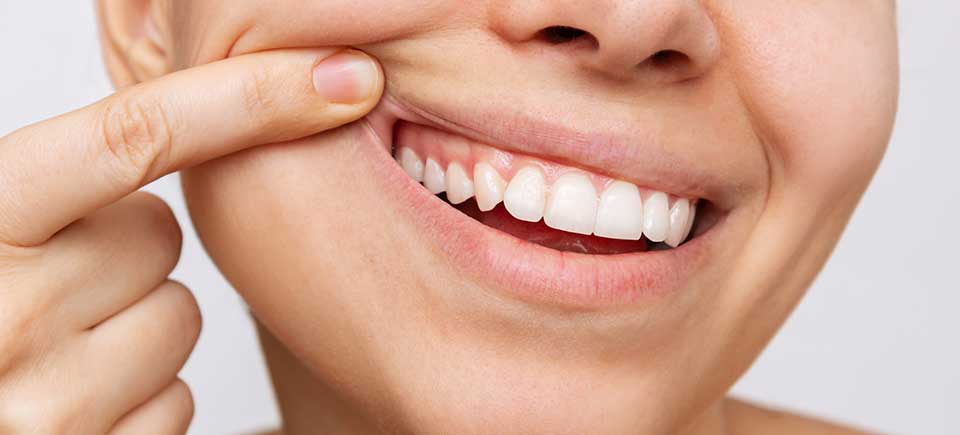Are you experiencing any pain or discomfort in your gums? Do you notice any changes in the color, texture, or shape of your gum tissues? If you answered yes to either of these questions, you might be experiencing early warning signs of unhealthy gums. At Reza Dental Care, our South Gate, CA dentists are committed to providing our patients with the best possible dental care. Knowing what to look for can help you get ahead of major oral health issues while they’re still easier to address.
Signs of Unhealthy Gums
Here are the top four warning signs that you have unhealthy gums:
1. Gum Recession
Gum recession is a common sign of unhealthy gums, brushing too aggressively, or advanced periodontal disease. Recession occurs when the gum tissue surrounding your teeth begins to pull back and away from the tooth, exposing the tooth surface. Since tooth roots aren’t covered by hard protective enamel, this can lead to tooth sensitivity, as well as an increased risk of tooth decay and gum disease.
If you notice that your teeth appear longer than usual, or if you experience sensitivity to hot or cold temperatures, you may be experiencing gum recession. You might even be able to tell that part of the tooth root is exposed if there is a noticeable difference in the color between your root and the top of the tooth (crown.) Most roots have a bit of a yellow tint to them.
2. Bleeding Gums
Bleeding is a very common sign of unhealthy gums. The good news is that sometimes bleeding gums may be due to the early onset of gingivitis, which is completely reversible with good home care and checkups. The bad news is that moderate to severe bleeding may indicate more aggressive oral disease.
Bleeding gums usually occur when you brush or floss your teeth, but only if your gums aren’t healthy. Bleeding gums are often due to an infection caused by the buildup of plaque. When the plaque isn’t thoroughly removed each day, your immune system reacts to the bacteria in those spaces, causing your gums to bleed. If you notice that your gums bleed whenever you brush or floss, you can have anything from minor gingivitis to more serious periodontal disease. While gingivitis is reversible, gum disease is not.
3. Swollen, Puffy Gums
Swollen, inflamed gingiva (gums) are another sign of unhealthy gums. Puffy gums can be caused by gum disease, as well as other factors such as pregnancy, hormonal changes, or certain medications. If you notice that your gums appear red, blue, purplish, swollen, or puffy, it is important to seek dental care to determine the cause of the swelling. Sometimes it’s due to plaque and tartar buildup lodged under the gums, which you can’t remove with a toothbrush or floss; a professional cleaning can help.
4. Red Gums
Red gums are a sign of inflammation and immune response, causing red blood cells and antibodies to rush into an area of infection. The red color can also take on a bluish or purple tint, depending on how chronic your gum infection is. Normal, healthy gum tissues should usually be a light coral-pink color, except for the few people with higher melanin levels whose gums may look brown or black. Anytime your gums look red, it’s important that you see our South Gate dentist for an exam.
How to Treat Unhealthy Gums
Diseased gum tissue isn’t just a risk to your smile. Sure, periodontal infections can cause tooth loss, but they also raise your chances of serious health issues like heart attack, stroke, and dozens of other medical conditions. Why? Because unhealthy gums allow bacteria to transfer from your mouth into your circulatory system, increasing inflammation in your body and straining your immune system. Treating unhealthy gums will better your overall health and help you keep your smile healthy for a lifetime.
Here are a few things to do if you have concerns about the health of your gums:
Better Brushing Techniques
One of the most important ways to treat unhealthy gums is to practice better brushing techniques. This includes brushing your teeth at least twice a day, for two minutes each time. Use a soft-bristled toothbrush and a fluoride toothpaste to gently clean your teeth and gums. Be sure to brush along the gum line, where plaque and bacteria can accumulate. Better yet, invest in an electric toothbrush to clean more effectively and stimulate your gum tissues while you’re at it.
Flossing Every Day
In addition to brushing, flossing every day is an essential part of maintaining healthy gums. Flossing helps to remove food particles and plaque from between your teeth and along your gum line. If you have trouble flossing, try using a floss pick, water flosser, or an interdental brush to clean between your teeth and gums. Our South Gate dental team can show you the easiest way to clean around your specific problem areas.
Gum Recession Treatments
Depending on the extent of your gum recession, there are several treatments that can help. Gum grafting is one great example. These treatments can help to restore your gum tissue and protect your teeth from further damage.
Getting Screened for Gum Disease
If you are experiencing any signs of unhealthy gums, it is important to get screened for gum disease by a dentist or dental hygienist. Our dental providers can perform a comprehensive assessment to determine the health of your gums and recommend appropriate care if necessary. Early detection and treatment of gum disease are essential to preventing further damage to your teeth and gums. Left untreated, periodontal disease causes bone loss, tooth mobility, and total tooth loss.
Periodontal Therapy
Active periodontal disease is best treated with a therapeutic deep cleaning. This can include scaling and root planing, antibiotic therapy, and other treatments to remove bacteria and plaque from your teeth and gums. Periodontal therapy can help to reduce inflammation and restore the health of your gums when paired with good home care.
Professional Cleanings Every Six Months
Scheduling a professional dental cleaning every six months can help you address unhealthy gums. If it’s been over six months since your last checkup, call Reza Dental Care today to reserve your next appointment.

